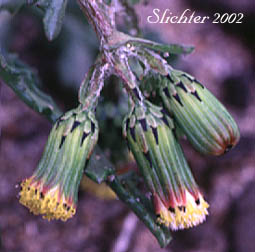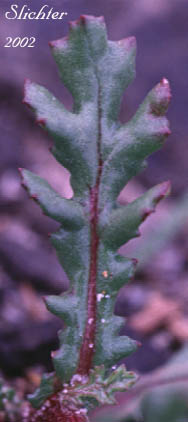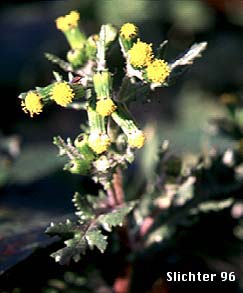

 The
photo at right shows a lower stem leaf of Common Groundsel.
The
photo at right shows a lower stem leaf of Common Groundsel.
Common groundsel is an annual weed with freely branched stems from 15-30 cm high, arising from a taproot. The herbage ranges from glabrous to somewhat tomentose. The leaves are oval to oblanceolate in outline with deeply pinnatifid to divided margins, the segments often toothed. Individual leaves range from 2-10 cm long and 0.5-4.5 cm wide. The upper leaf surface is bright green while the undersurface may be purplish in color. The upper leaves are stalkless with clasping bases and are coarsely to irregularly toothed.
The flower heads are in close terminal clusters at the ends of the branches, or from the upper leaf axils. The cylindrical involucre is 6-8 mm high with 16-22 bracts, many of which are black-tipped. The involucral bracts are yellowish-green in color. The flowers are all discoid with the disk measuring from 5-10 mm wide.
Common butterweed grows rapidly, with plants producing seeds within 5 weeks of germination. It is an opportunistic weed and soon covers disturbed ground. Plants have even been known to flower at temperatures below 0¾C.
Common groundsel is a weedy species commonly found in disturbed or cultivated areas, including yards, gardens and fields. Within the area east of the Cascade Mts., it is occasionally found in moister habitats.
Common groundsel is an introduced plant from Europe. It is widely distributed across much of North America, although it is not commonly found in the drier areas to the east of the Cascade Mts.
The plants were originally brought to North America in 1620 by the Pilgrims as a potential treatment for the early stages of cholera.
